Category Archive 'History'
03 Jul 2022


For every Southern boy fourteen years old, not once but whenever he wants it, there is the instant when it’s still not yet two o’clock on that July afternoon in 1863, the brigades are in position behind the rail fence, the guns are laid and ready in the woods and the furled flags are already loosened to break out and Pickett himself with his long oiled ringlets and his hat in one hand probably and his sword in the other looking up the hill waiting for Longstreet to give the word and it’s all in the balance, it hasn’t happened yet, it hasn’t even begun yet, it not only hasn’t begun yet but there is still time for it not to begin against that position and those circumstance which made more men than Garnett and Kemper and Armistead and Wilcox look grave yet it’s going to begin, we all know that, we have come too far with too much at stake and that moment doesn’t need even a fourteen-year-old boy to think This time. Maybe this time with all this much to lose than all this much to gain: Pennsylvania, Maryland, the world, the golden dome of Washington itself to crown with desperate and unbelievable victory the desperate gamble, the cast made two years ago.
—William Faulkner, Intruder in the Dust, 1948.
03 Jul 2022

Crossing the Emmitsburg Road.
——————————————————–

“Give them cold steel.” — Brigadier General Lewis Armistead (February 18, 1817–July 3, 1863)
——————————————————–
Dr. Joseph Hold of the 11th Mississippi, Davis’s brigade, anticipated that the afternoon would be busy and set up his dressing station early in a shelter behind Seminary Ridge. . .When the cannonade opened and the Federals’ guns replied, stretcher bearers, crouching low, began bringing in the wounded. Among the first was an athletic young man with reddish golden hair, “a princely fellow,” the doctor called him, with a calm manner and a delightful smile, one of that gay, turbulent company that had left with the University Greys of Oxford to form Company A of the 11th Mississippi.
The physician examined the left arm, cut off at the elbow, and offered encouragement.
“Why, doctor, that isn’t where I am hurt.” The boy pulled back a blanket and showed where a shell had ripped deep across his abdomen, carrying away much that was vital. “I am in great agony,” he said, still smiling. “Let me die easy, dear doctor.”
But before the lad had drunk the cup containing the concentrated solution of opium, the doctor held up his right arm so he could write: “My dear mother. . .Remember that I am true to my country and my regret at dying is that she is not free. . .you must not regret that my body cannot be obtained. It is a mere matter of form anyhow. . .Send my dying release to Miss Mary. . .” He signed, JERE S. GAGE, Co. A, 11 Miss. By that time, the letter was covered with blood.
Then he raised his cup to a group of soldiers. “I do not invite you to drink with me,” he remarked wryly, then with fervor, “but I drink a toast to you, the Southern Confederacy, and to victory.”
* * *
Then Pickett stood in front of his division and gave the final word: “Charge the enemy and remember old Virginia!” His voice was clear and strong as he spoke the order: “Forward! Guide center! March!” . . .
“I don’t want to make this charge,” Longstreet declared emphatically. “I don’t believe it can succeed. I would stop Pickett now, but that General Lee has ordered it and expects it.”
Further remarks showed he wanted some excuse for calling off the whole attack.
But Longstreet and Alexander had lost control. As they talked, the turf trembled about them and the long line of grey infantry broke from the woods. First came Garnett’s Virginians, the general in front, his old blue overcoat buttoned tightly around his neck. Abreast was Kemper’s trim line marching majestically into the open fields, the fifes piping “Dixie,” the ranks in nearly perfect alignment. Far to the left could be heard the drum rolls of the Carolina regiments — Pettigrew and Trimble were in motion. The hour of the generals had passed. The infantrymen from the Richmond offices and Pearisburg farmlands, the “Greys” from the halls of “Old Miss” and the “flower of the Cape Fear section,” had taken the Confederate cause into their hands.
* * *
The assaulting column consisted of 41 regiments and one battalion. . .Nineteen of the regiments were from Virginia, 15 from North Carolina, 3 each from Tennessee and Mississippi, and one regiment and one battalion from Alabama.
* * *
Garnett, with a big voice issuing from his frail body, rode ahead of his line regulating the pace, admonishing his men not to move too rapidly. From the skirmish line, Captain Shotwell obtained one of the rare views of the Confederate advance: the “glittering forest of bright bayonets,” the column coming down the slope “in superb alignment,” the “murmur and jingle” and “rustle of thousands of feet amid the stubble” which stirred up a cloud of dust “like the dash of spray at the prow of a vessel.”
In front of Pickett flew the blue banner of the Old Dominion with the motto, “Sic Semper Tyrannis,” and the Stars and Bars of the Confederacy (the red battle flag with its blue cross not yet being in general use). The regimental flags flapped. A soft warm wind was blowing from the land they loved.
Glenn Tucker, “High Tide at Gettysburg.”
07 Jun 2022

Taos Pueblo, continuously inhabited for over 1000 years, built between 1100 and 1450 A.D.
The Archive exhibits ten buildings predating the United States.
23 Apr 2022

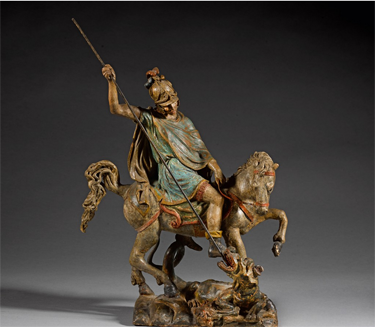
St. George, Italy, late 17th — early 18th Century.
Paul Kingsnorth, at the Abbey of Misrule, considers the appropriateness of St. George as England’s patron and has some good words for the dragon.
Back in the day, I was rooting for the dragon. It was a thing that some of us did back in the prehistoric nineties. Among the young, crusty eco-activists of yore, the myth of St George, patron saint of England, was another old story that needed to be turned on its head. As we battled to stop yet another square mile of English soil being concreted over for a motorway extension, superstore, housing estate, airport runway or whatever other embodiment of Progress was ‘necessary’ this week, we would hold up the dragon, not the saint, as our guiding light. This armoured human dealing out death to this innocent, wild creature: wasn’t it so appropriate that he would be the patron saint of this most modern and destructive of nations? The dragon, on the other hand was the icon of wildness, of untamed nature resisting the onslaught. Why couldn’t he be our saint instead?
As it happens, the dragon was once the symbol of England, back when St George was nowhere to be found. On Senlac Hill in 1066, Harold Godwinson, the last English king, was said to have fought William the Bastard’s Norman invaders under two banners: the dragon of Wessex, and the ‘fighting man’. The latter is still a mystery, and an intriguing one (I’ve often idly wondered if it looked anything like this.) But the dragon – or wyrm, to use the Old English – still flies on the official flag of Wessex today.
The king was defeated that day, of course – a story I wrote once – and the England which once flew the banner of the dragon now flies the banner of its slayer. But it always seemed to me, even when I was writing books about the state of England, that the English don’t care much for their patron saint. Perhaps we don’t care for any saints, and maybe that’s what haunts us. We wrecked most of their shrines during the Reformation, after all, and what did our national church replace them with? Ah yes: Helter Skelters.
RTWT
17 Apr 2022

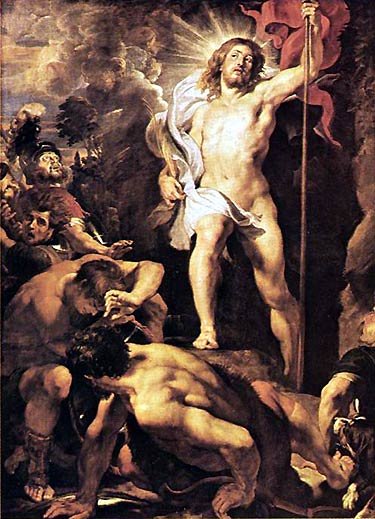
Peter Paul Rubens, The Resurrection of Christ, 1611-1612, Vrouwekathedraal, Antwerp
From Robert Chambers, The Book of Days, 1869:
Easter
Easter, the anniversary of our Lord’s resurrection from the dead, is one of the three great festivals of the Christian year,—the other two being Christmas and Whitsuntide. From the earliest period of Christianity down to the present day, it has always been celebrated by believers with the greatest joy, and accounted the Queen of Festivals. In primitive times it was usual for Christians to salute each other on the morning of this day by exclaiming, ‘Christ is risen;’ to which the person saluted replied, ‘Christ is risen indeed,’ or else, ‘ And hath appeared unto Simon;’—a custom still retained in the Greek Church. Easter retains many religious customs today but there are also many commercial aspects to the holiday. The Easter bunny, Easter candy and Easter baskets are all part of the celebration. Giving Easter baskets filled with candy is a joyous family activity, but it is important to remember the true meaning of the Easter holiday. Read the rest of this entry »
17 Mar 2022

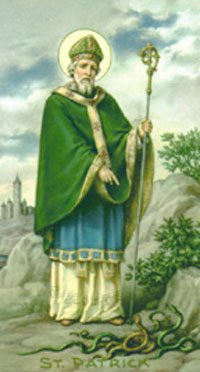
From Robert Chambers, The Book of Days, 1869:
LEGENDARY HISTORY OF ST. PATRICK
Almost as many countries arrogate the honour of having been the natal soil of St. Patrick, as made a similar claim with respect to Homer. Scotland, England, France, and Wales, each furnish their respective pretensions: but, whatever doubts may obscure his birthplace, all agree in stating that, as his name implies, he was of a patrician family. He was born about the year 372, and when only sixteen years of age, was carried off by pirates, who sold him into slavery in Ireland; where his master employed him as a swineherd on the well-known mountain of Sleamish, in the county of Antrim. Here he passed seven years, during which time he acquired a knowledge of the Irish language, and made himself acquainted with the manners, habits, and customs of the people. Escaping from captivity, and, after many adventures, reaching the Continent, he was successively ordained deacon, priest, and bishop: and then once more, with the authority of Pope Celestine, he returned to Ireland to preach the Gospel to its then heathen inhabitants.
The principal enemies that St. Patrick found to the introduction of Christianity into Ireland, were the Druidical priests of the more ancient faith, who, as might naturally be supposed, were exceedingly adverse to any innovation. These Druids, being great magicians, would have been formidable antagonists to any one of less miraculous and saintly powers than Patrick. Their obstinate antagonism was so great, that, in spite of his benevolent disposition, he was compelled to curse their fertile lands, so that they became dreary bogs: to curse their rivers, so that they produced no fish: to curse their very kettles, so that with no amount of fire and patience could they ever be made to boil; and, as a last resort, to curse the Druids themselves, so that the earth opened and swallowed them up. …
The greatest of St. Patrick’s miracles was that of driving the venomous reptiles out of Ireland, and rendering the Irish soil, for ever after, so obnoxious to the serpent race, that they instantaneously die on touching it. Colgan seriously relates that St. Patrick accomplished this feat by beating a drum, which he struck with such fervour that he knocked a hole in it, thereby endangering the success of the miracle. But an angel appearing mended the drum: and the patched instrument was long exhibited as a holy relic. …
When baptizing an Irish chieftain, the venerable saint leaned heavily on his crozier, the steel-spiked point of which he had unwittingly placed on the great toe of the converted heathen. The pious chief, in his ignorance of Christian rites, believing this to be an essential part of the ceremony, bore the pain without flinching or murmur; though the blood flowed so freely from the wound, that the Irish named the place St. fhuil (stream of blood), now pronounced Struill, the name of a well-known place near Downpatrick. And here we are reminded of a very remarkable fact in connection with geographical appellations, that the footsteps of St. Patrick can be traced, almost from his cradle to his grave, by the names of places called after him.
Thus, assuming his Scottish origin, he was born at Kilpatrick (the cell or church of Patrick), in Dumbartonshire. He resided for some time at Dalpatrick (the district or division of Patrick), in Lanarkshire; and visited Crag-phadrig (the rock of Patrick), near Inverness. He founded two churches, Kirkpatrick at Irongray, in Kireudbright; and Kirkpatrick at Fleming, in Dumfries: and ultimately sailed from Portpatrick, leaving behind him such an odour of sanctity, that among the most distinguished families of the Scottish aristocracy, Patrick has been a favourite name down to the present day.
Arriving in England, he preached in Patterdale (Patrick’s dale), in Westmoreland: and founded the church of Kirkpatrick, in Durham. Visiting Wales, he walked over Sarn-badrig (Patrick’s causeway), which, now covered by the sea, forms a dangerous shoal in Carnarvon Bay: and departing for the Continent, sailed from Llan-badrig (the church of Patrick), in the island of Anglesea. Undertaking his mission to convert the Irish, he first landed at Innis-patrick (the island of Patrick), and next at Holmpatrick, on the opposite shore of the mainland, in the county of Dublin. Sailing northwards, he touched at the Isle of Man, sometimes since, also, called. Innis-patrick, where he founded another church of Kirkpatrick, near the town of Peel. Again landing on the coast of Ireland, in the county of Down, he converted and baptized the chieftain Dichu, on his own threshing-floor. The name of the parish of Saul, derived from Sabbal-patrick (the barn of Patrick), perpetuates the event. He then proceeded to Temple-patrick, in Antrim, and from thence to a lofty mountain in Mayo, ever since called Croagh-patrick.
He founded an abbey in East Meath, called Domnach-Padraig (the house of Patrick), and built a church in Dublin on the spot where St. Patrick’s Cathedral now stands. In an island of Lough Deng, in the county of Donegal, there is St. Patrick’s Purgatory: in Leinster, St. Patrick’s Wood; at Cashel, St. Patrick’s Rock; the St. Patrick’s Wells, at which the holy man is said to have quenched his thirst, may be counted by dozens. He is commonly stated to have died at Saul on the 17th of March 493, in the one hundred and twenty-first year of his age. …
The shamrock, or small white clover (trifolium repens of botanists), is almost universally worn in the hat over all Ireland, on St. Patrick’s day. The popular notion is, that when St. Patrick was preaching the doctrine of the Trinity to the pagan Irish, he used this plant, bearing three leaves upon one stem, as a symbol or illustration of the great mystery. To suppose, as some absurdly hold, that he used it as an argument, would be derogatory to the saint’s high reputation for orthodoxy and good sense: but it is certainly a curious coincidence, if nothing more, that the trefoil in Arabic is called skamrakh, and was held sacred in Iran as emblematical of the Persian Triads. Pliny, too, in his Natural History, says that serpents are never seen upon trefoil, and it prevails against the stings of snakes and scorpions. This, considering St. Patrick’s connexion with snakes, is really remarkable, and we may reasonably imagine that, previous to his arrival, the Irish had ascribed mystical virtues to the trefoil or shamrock, and on hearing of the Trinity for the first time, they fancied some peculiar fitness in their already sacred plant to shadow forth the newly revealed and mysterious doctrine. …
In the Galtee or Gaultie Mountains, situated between the counties of Cork and Tipperary, there are seven lakes, in one of which, called Lough Dilveen, it is said Saint Patrick, when banishing the snakes and toads from Ireland, chained a monster serpent, telling him to remain there till Monday.
The serpent every Monday morning calls out in Irish, ‘It is a long Monday, Patrick.’
That St Patrick chained the serpent in Lough Dilveen, and that the serpent calls out to him every Monday morning, is firmly believed by the lower orders who live in the neighbourhood of the Lough.
01 Mar 2022


What does Putin think he’s doing?
Red State found an article that appeared in three different Russian regime outlets on February 27th (since withdrawn, probably because the Invasion of Ukraine, contrary to Kremlin expectation, did not quickly topple the pro-Western Government and lead to a quick surrender and occupation).
Choice excerpts:
A new world is being born before our eyes. Russia’s military operation in Ukraine has ushered in a new era – and in three dimensions at once. And of course, in the fourth, internal Russian. Here begins a new period both in ideology and in the very model of our socio-economic system – but this is worth talking about separately a little later.
Russia is restoring its unity – the tragedy of 1991, this terrible catastrophe in our history, its unnatural dislocation, has been overcome. Yes, at a great cost, yes, through the tragic events of a virtual civil war, because now brothers, separated by belonging to the Russian and Ukrainian armies, are still shooting at each other, but there will be no more Ukraine as anti-Russia. Russia is restoring its historical fullness, gathering the Russian world, the Russian people together – in its entirety of Great Russians, Belarusians and Little Russians. If we had abandoned this, if we had allowed the temporary division to take hold for centuries, then we would not only betray the memory of our ancestors, but would also be cursed by our descendants for allowing the disintegration of the Russian land.
…
Now this problem is gone – Ukraine has returned to Russia. This does not mean that its statehood will be liquidated, but it will be reorganized, re-established and returned to its natural state of part of the Russian world. In what borders, in what form will the alliance with Russia be fixed (through the CSTO and the Eurasian Union or the Union State of Russia and Belarus )? This will be decided after the end is put in the history of Ukraine as anti-Russia. In any case, the period of the split of the Russian people is coming to an end.
And here begins the second dimension of the coming new era – it concerns Russia’s relations with the West. Not even Russia, but the Russian world, that is, three states, Russia, Belarus and Ukraine, acting in geopolitical terms as a single whole. These relations have entered a new stage – the West sees the return of Russia to its historical borders in Europe . And he is loudly indignant at this, although in the depths of his soul he must admit to himself that it could not be otherwise.
…
Because the construction of a new world order – and this is the third dimension of current events – is accelerating, and its contours are more and more clearly visible through the spreading cover of Anglo-Saxon globalization. A multipolar world has finally become a reality – the operation in Ukraine is not capable of rallying anyone but the West against Russia. Because the rest of the world sees and understands perfectly well – this is a conflict between Russia and the West, this is a response to the geopolitical expansion of the Atlanticists, this is Russia’s return of its historical space and its place in the world.
This makes perfect sense. Vladimir Putin subscribes to the traditional claim of the despotic ruler of the duchy of Moscow to be the inheritor of Kievian Rus and the new Caesar presiding over the Third Rome.
Invading, subjugating, and occupying neighboring states is just the perfectly legitimate and obligatory task of “gathering the Russian lands,” i.e. gaining control over White, Black, and Little Russia and ruling all Eastern Slavic language speakers. Norman Davies, in God’s Playground, a History of Poland, compares this insolent pretention to some minor duke in Brittany asserting a claimed right to gather and rule all the Celtic lands.
Of course, the duke of Moscow traditionally not only claimed a right to possession of “all the Russian lands.” He additionally claimed a vital state interest in possessing an additional cordon sanitaire of puppet states surrounding Russia’s Western borders, purely to protect the Motherland from the constant, frightful threat of attack from Western Europe!
26 Feb 2022

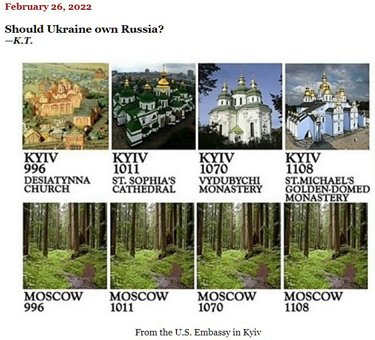
The Eastern Slavic state started with Kiev, and the Eastern Slavs became part of Western Civilization when Saint Vladimir the ruler of Kievian Rus’ converted to Christianity.
Moscow was founded as just another city/state of Kievian Rus’.
The city-states of White and Black Russia were referred to as Rus’ [Roosh]. Moscow was called Rossiya.
The history of the Eastern Slavs diverged in the 1240s as the result of the Great Mongol Invasion. Kievian Rus’ was swept away. Kiev resisted and was destroyed. Moscow surrendered to the Horde, and the dukes of Moscow (the ancestors of later self-styled “Caesars,” the first of whom bestowed that title on himself following his marriage in 1472 to a princess of defunct Byzantium, fallen to the Turks in 1453) served as tax collectors to the Horde and knocked their foreheads on the ground in submission to the Khan at Sarai.
White and Black Russia (today’s Belarus) sought the protection of the mLithuanian princes and joined Lithuania and consequently were never taken by the Mongols. Ukraine was liberated via a Reconquista by the Lithuanians piece by piece with Grand Duke Vytautas finishing standing by the Black Sea in 1399.
The Cossacks, referred to in Ace’s history, began as escaped Lithuanian serfs who fled to the uninhabited steppe borderlands, intermarried with the Tartars, and lived as outlaw brigands, preying on the Turks.
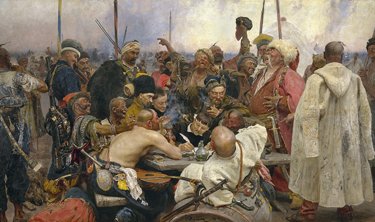
Ilya Repin, Запорожцы пишут письмо турецкому султану, [Cossacks write a letter to the Turkish sultan], 1880-1891, State Russian Museum, Saint Petersburg.
In 1569, the Lithuanian dynasty ruling the combined state of Poland-Lithuania (formed in 1386, when the Lithuanian Grand Duke married the Polish Queen, converted to Christianity from Paganism, and became King of Poland, was doomed to expire because Sigismund Augustus refused to remarry when Barbara Radziwill, the love of his life died suddenly. “He left no heir but Liberty,” was the saying.

Jósef Simmler, Śmierć Barbary Radziwiłłówny [Death of Barbara Radziwill].
1860. National Musem, Warsaw.
Via the Union of Lublin, ties between Poland-Lithuania were strengthened, two parliaments were merged into one, and “The Union of Both Nations” became a Republic with an elective monarchy. In the course of the manueverings toward Union, Sigismund Augustus twisted the arms of reluctant Lithuanian magnates by transferring Ukraine from Lithuanian Administration to Poland.
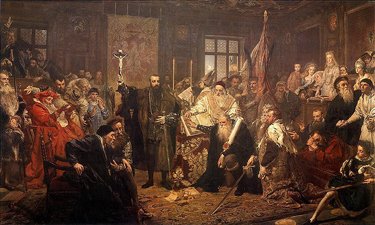
Jan Matejko, Unia Lubelska [The Union of Lublin]. 1869. Muzeum Narodowe w Warszawie. Depozyt w Muzeum Okregowym w Lublinie.
This transfer of authority was not terribly successful. A great Cossack Rebellion, 1648-1657, was a bloodbath which led to the acquisition of Eastern Ukraine by Muscovy in 1654, and which marked the beginning of “the gathering of the Russian lands” by the despots of Moscow.
The rest of Ukraine was acquired by Moscow via the three Partitions of Poland in 1772, 1793, and 1795. The Russian Occupation of Poland, Lithuania, and Ukraine was resisted 1793-1795 under Kosciuszko, 1795-1815 in the Napoleonic Wars, 1831-1832 in the November Insurrection, 1863-1864 in the January Insurrection, and so on.
24 Feb 2022


April 1945. Once the conqueror of Europe, the Bohemian corporal who rose from the slums of Munich and Vienna to perform a spontaneous little dance of joy outside the railroad carriage in which the Armistice of 1918 was signed, having just compelled the proud French to dine on the same unappetizing meal of humiliation and surrender previously served up to Germany, is now trapped like a rat in the catacombs beneath the Reichs Chancellery, listening to the nearby fighting and the shells falling outside his bunker while enemy forces draw closer and closer, with a cyanide capsule and a Walther pistol as his best remaining choice.
How did it come to this?
Hitler destroyed himself and his short-lived Reich by pushing his luck too far, intoxicated by the phantom allure of a terribly bad idea which was both impractically unattainable and of no real relevance to reality.
Hitler’s ideology was, at root, a sort of political patent medicine combining German Romanticism with Populism and technological Futurism. That mixture had considerable appeal, outmarketing thuggish and divisive Bolshevism as well as milk-and-water Social Democracy. But Hitler was only an autodidact café intellectual and putting him in charge of a major country was a very bad idea.
Hitler’s big idea in the realm of Foreign Policy simply amounted to reversing German losses consequent to WWI and the Treaty of Versailles, then proceeding to implement a humongous modern revival of the Teutonic Drang nach Osten that would enserf (or alternatively eliminate) Slavic populations to the East and take over their lands giving the German people (supposedly vital) Lebensraum and control of natural resources, particularly coal and petroleum.
This sort of stuff sounded great to German Nationalists, living mentally in the 19th Century, but all the racialist nonsense motivating and justifying this kind of barbarous piratical policy was nonsense. Germans and Slavs differed in linguistic traditions, but had lived as neighbors, immemorially, for countless centuries, intermarrying and mixing economically and culturally and politically. A “Hitler” is a Hüttler (also spelled Huettler), meaning “one who lives in a hut”, from Hütte (“hut”) and most probably of Slavic origin.
Even the Germans noticed the ironies of those racialist theories, and commonly joked that “the ideal Nazi was someone as tall as Goebbels, as slim as Goering, and as blond as Hitler.”
And a “Drang nach Osten” that required 52 million Germans to defeat 170.5 million Russian, 131 million Americans, 545 million from the British Commonwealth, &c., &c. that pitted the German economy as well against the US economy, the British economy, that effectively pitted Germany and Italy, and Japan against most of the rest of the world was never going to work out successfully.
Karl Marx said that history repeats itself, first as tragedy, then as farce, and he might very well have been speaking of WWII followed by Vladimir Putin’s newly implemented war to restore the Soviet Empire and to reverse the result of the Cold War. Read the rest of this entry »
14 Feb 2022

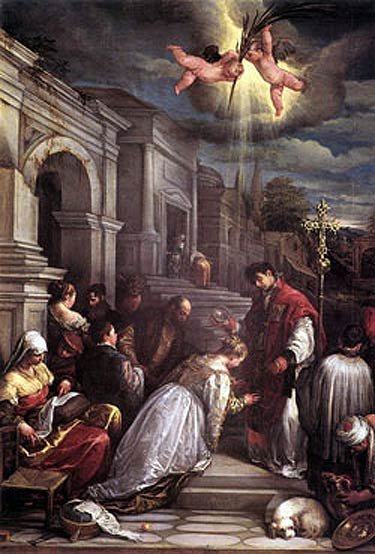
Jacopo Bassano, St Valentine Baptizing St Lucilla, 1575, oil on canvas, Museo Civico, Bassano del Grappa
The popular customs associated with Saint Valentine’s Day undoubtedly had their origin in a conventional belief generally received in England and France during the Middle Ages, that on 14 February, i.e., half way through the second month of the year, the birds began to pair. Thus in Chaucer’s Parliament of Foules we read:
For this was sent on Seynt Valentyne’s day
Whan every foul cometh ther to choose his mate.
For this reason the day was looked upon as specially consecrated to lovers and as a proper occasion for writing love letters and sending lovers’ tokens. Both the French and English literatures of the fourteenth and fifteenth centuries contain allusions to the practice. Perhaps the earliest to be found is in the 34th and 35th Ballades of the bilingual poet, John Gower, written in French; but Lydgate and Clauvowe supply other examples. Those who chose each other under these circumstances seem to have been called by each other their Valentines.
In the Paston Letters, Dame Elizabeth Brews writes thus about a match she hopes to make for her daughter (we modernize the spelling), addressing the favoured suitor:
And, cousin mine, upon Monday is Saint Valentine’s Day and every bird chooses himself a mate, and if it like you to come on Thursday night, and make provision that you may abide till then, I trust to God that ye shall speak to my husband and I shall pray that we may bring the matter to a conclusion.
——————————————–
From Robert Chambers, The Book of Days, 1869: Feast Day: St. Valentine, priest and martyr, circ. 270.
Valentine’s Day is now almost everywhere a much degenerated festival, the only observance of any note consisting merely of the sending of jocular anonymous letters to parties whom one wishes to quiz, and this confined very much to the humbler classes. The approach of the day is now heralded by the appearance in the print-sellers’ shop windows of vast numbers of missives calculated for use on this occasion, each generally consisting of a single sheet of post paper, on the first page of which is seen some ridiculous coloured caricature of the male or female figure, with a few burlesque verses below. More rarely, the print is of a sentimental kind, such as a view of Hymen’s altar, with a pair undergoing initiation into wedded happiness before it, while Cupid flutters above, and hearts transfixed with his darts decorate the corners. Maid-servants and young fellows interchange such epistles with each other on the 14th of February, no doubt conceiving that the joke is amazingly good: and, generally, the newspapers do not fail to record that the London postmen delivered so many hundred thousand more letters on that day than they do in general. Such is nearly the whole extent of the observances now peculiar to St. Valentine’s Day.
At no remote period it was very different. Ridiculous letters were unknown: and, if letters of any kind were sent, they contained only a courteous profession of attachment from some young man to some young maiden, honeyed with a few compliments to her various perfections, and expressive of a hope that his love might meet with return. But the true proper ceremony of St. Valentine’s Day was the drawing of a kind of lottery, followed by ceremonies not much unlike what is generally called the game of forfeits. Misson, a learned traveller, of the early part of the last century, gives apparently a correct account of the principal ceremonial of the day.
‘On the eve of St. Valentine’s Day,’ he says, ‘the young folks in England and Scotland, by a very ancient custom, celebrate a little festival. An equal number of maids and bachelors get together: each writes their true or some feigned name upon separate billets, which they roll up, and draw by way of lots, the maids taking the men’s billets, and the men the maids’: so that each of the young men lights upon a girl that he calls his valentine, and each of the girls upon a young man whom she calls hers. By this means each has two valentines: but the man sticks faster to the valentine that has fallen to him than to the valentine to whom he is fallen. Fortune having thus divided the company into so many couples, the valentines give balls and treats to their mistresses, wear their billets several days upon their bosoms or sleeves, and this little sport often ends in love.’
…
St. Valentine’s Day is alluded to by Shakspeare and by Chaucer, and also by the poet Lydgate (who died in 1440). …
The origin of these peculiar observances of St. Valentine’s Day is a subject of some obscurity. The saint himself, who was a priest of Rome, martyred in the third century, seems to have had nothing to do with the matter, beyond the accident of his day being used for the purpose. Mr. Douce, in his Illustrations of Shakspeare, says:
‘It was the practice in ancient Rome, during a great part of the month of February, to celebrate the Lupercalia, which were feasts in honour of Pan and Juno. whence the latter deity was named Februata, Februalis, and Februlla. On this occasion, amidst a variety of ceremonies, the names of young women were put into a box, from which they were drawn by the men as chance directed. The pastors of the early Christian church, who, by every possible means, endeavoured to eradicate the vestiges of pagan superstitions, and chiefly by some commutations of their forms, substituted, in the present instance, the names of particular saints instead of those of the women: and as the festival of the Lupercalia had commenced about the middle of February, they appear to have chosen St. Valentine’s Day for celebrating the new feast, because it occurred nearly at the same time.
This is, in part, the opinion of a learned and rational compiler of the Lives of the Saints, the Rev. Alban Butler.
It should seem, however, that it was utterly impossible to extirpate altogether any ceremony to which the common people had been much accustomed—a fact which it were easy to prove in tracing the origin of various other popular superstitions. And, accordingly, the outline of the ancient ceremonies was preserved, but modified by some adaptation to the Christian system. It is reasonable to suppose, that the above practice of choosing mates would gradually become reciprocal in the sexes, and that all persons so chosen would be called Valentines, from the day on which the ceremony took place.’
***********************************************
February 14th, prior to 1969, was the feast day of two, or possibly three, saints and martyrs named Valentine, all reputedly of the Third Century.
The first Valentine, legend holds, was a physician and priest in Rome, arrested for giving aid to martyrs in prison, who while there converted his jailer by restoring sight to the jailer’s daughter. He was executed by being beaten with clubs, and afterwards beheaded, February 14, 270. He is traditionally the patron of affianced couples, bee keepers, lovers, travellers, young people, and greeting card manufacturers, and his special assistance may be sought in conection with epilepsy, fainting, and plague.
A second St. Valentine, reportedly bishop of Interamna (modern Terni) was also allegedly martyred under Claudius II, and also allegedly buried along the Flaminian Way.
A third St. Valentine is said to have also been martyred in Roman times, along with companions, in Africa.
Due to an insufficiency of historical evidence in the eyes of Vatican II modernizers, the Roman Catholic Church dropped the February 14th feast of St. Valentine from its calendar in 1969.
02 Feb 2022

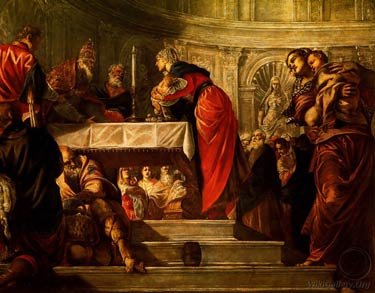
Tintoretto, Presentation of Jesus at the Temple, 1550-1555, Gallerie dell Accademi, Venice
From Robert Chambers, The Book of Days, 1869:
From a very early, indeed unknown date in the Christian history, the 2nd of February has been held as the festival of the Purification of the Virgin, and it is still a holiday of the Church of England. From the coincidence of the time with that of the Februation or purification of the people in pagan Rome, some consider this as a Christian festival engrafted upon a heathen one, in order to take advantage of the established habits of the people; but the idea is at least open to a good deal of doubt. The popular name Candlemass is derived from the ceremony which the Church of Rome dictates to be observed on this day; namely, a blessing of candles by the clergy, and a distribution of them amongst the people, by whom they are afterwards carried lighted in solemn procession. The more important observances were of course given up in England at the Reformation; but it was still, about the close of the eighteenth century, customary in some places to light up churches with candles on this day.
At Rome, the Pope every year officiates at this festival in the beautiful chapel of the Quirinal. When he has blessed the candles, he distributes them with his own hand amongst those in the church, each of whom, going singly up to him, kneels to receive it. The cardinals go first; then follow the bishops, canons, priors, abbots, priests, &c., down to the sacristans and meanest officers of the church. According to Lady Morgan, who witnessed the ceremony in 1820:
‘When the last of these has gotten his candle, the poor conservatori, the representatives of the Roman senate and people, receive theirs. This ceremony over, the candles are lighted, the Pope is mounted in his chair and carried in procession, with hymns chanting, round the ante-chapel; the throne is stripped of its splendid hangings; the Pope and cardinals take off their gold and crimson dresses, put on their usual robes, and the usual mass of the morning is sung.’
Lady Morgan mentions that similar ceremonies take place in all the parish churches of Rome on this day.
It appears that in England, in Catholic times, a meaning was attached to the size of the candles, and the manner in which they burned during the procession; that, moreover, the reserved parts of the candles were deemed to possess a strong supernatural virtue:
‘This done, each man his candle lights,
Where chiefest seemeth he,
Whose taper greatest may be seen; And fortunate to be,
Whose candle burneth clear and bright: A wondrous force and might
Both in these candles lie, which if At any time they light,
They sure believe that neither storm Nor tempest cloth abide,
Nor thunder in the skies be heard, Nor any devil’s spide,
Nor fearful sprites that walk by night,
Nor hurts of frost or hail,’ &c.
The festival, at whatever date it took its rise, has been designed to commemorate the churching or purification of Mary; and the candle-bearing is understood to refer to what Simeon said when he took the infant Jesus in his arms, and declared that he was a light to lighten the Gentiles. Thus literally to adopt and build upon metaphorical expressions, was a characteristic procedure of the middle ages. Apparently, in consequence of the celebration of Mary’s purification by candle-bearing, it became customary for women to carry candles with them, when, after recovery from child-birth, they went to be, as it was called, churched. A remarkable allusion to this custom occurs in English history. William the Conqueror, become, in his elder days, fat and unwieldy, was confined a considerable time by a sickness. ‘Methinks,’ said his enemy the King of France, ‘the King of England lies long in childbed.’ This being reported to William, he said, ‘When I am churched, there shall be a thousand lights in France !’ And he was as good as his word; for, as soon as he recovered, he made an inroad into the French territory, which he wasted wherever he went with fire and sword.
At the Reformation, the ceremonials of Candlemass day were not reduced all at once. Henry VIII proclaimed in 1539:
‘On Candlemass day it shall be declared, that the bearing of candles is done in memory of Christ, the spiritual light, whom Simeon did prophesy, as it is read in. the church that day.’
It is curious to find it noticed as a custom down to the time of Charles II, that when lights were brought in at nightfall, people would say–‘God send us the light of heaven!’ The amiable Herbert, who notices the custom, defends it as not superstitious. Some-what before this time, we find. Herrick alluding to the customs of Candlemass eve: it appears that the plants put up in houses at Christmas were now removed.
Down with the rosemary and bays,
Down with the mistletoe;
Instead of holly now upraise
The greener box for show.
The holly hitherto did sway,
Let box now domineer,
Until the dancing Easter day
Or Easter’s eve appear.
The youthful box, which now hath grace
Your houses to renew,
Grown old, surrender must his place
Unto the crisped yew.
When yew is out, then birch comes in,
And many flowers beside,
Both of a fresh and fragrant kin’,
To honour Whitsuntide.
Green rushes then, and sweetest bents,
With cooler oaken boughs,
Come in for comely ornaments,
To re-adorn the house.
Thus times do shift; each thing in turn does hold;
New things succeed, as former things grow old.’
The same poet elsewhere recommends very particular care in the thorough removal of the Christmas garnishings on this eve:
‘That so the superstitious find
No one least branch left there behind;
For look, how many leaves there be
Neglected there, maids, trust to me,
So many goblins you shall see.’
He also alludes to the reservation of part of the candles or torches, as calculated to have the effect of protecting from mischief:
‘Kindle the Christmas brand, and then
Till sunset let it burn,
Which quenched, then lay it up again, Till Christmas next return.
Part must be kept, wherewith to tend
The Christmas log next year;
And where ‘tis safely kept, the fiend Can do no mischief there.’
Considering the importance attached to Candlemass day for so many ages, it is scarcely surprising that there is a universal superstition throughout Christendom, that good weather on this day indicates a long continuance of winter and a bad crop, and that its being foul is, on the contrary, a good omen. Sir Thomas Browne, in his Vulgar Errors, quotes a Latin distich expressive of this idea:
‘Si sol splendescat Maria purificante,
Major erit glacies post festum quam fait ante;
which maybe considered as well translated in the popular Scottish rhyme:
If Candlemass day be dry and fair,
The half o’ winter’s to come and mair;
If Candlemass day be wet and foul,
The half o’ winter’s gave at Yule.’
In Germany there are two proverbial expressions on this subject: 1. The shepherd would rather see the wolf enter his stable on Candlemass day than the sun; 2. The badger peeps out of his hole on Candlemass day, and when he finds snow, walks abroad; but if he sees the sun shining, he draws back into his hole. It is not improbable that these notions, like the festival of Candlemass itself, are derived from pagan times, and have existed since the very infancy of our race. So at least we may conjecture, from a curious passage in Martin’s Description of the Western Islands. On Candlemass day, according to this author, the Hebrideans observe the following curious custom:
The mistress and servants of each family take a sheaf of oats and dress it up in women’s apparel, put it in a large basket, and lay a wooden club by it, and this they call Brύd’s Bed.; and then the mistress and servants cry three times, “Brύd is come; Brύd is welcome!” This they do just before going to bed, and when they rise in the morning they look among the ashes, expecting to see the impression of Brύd’s club there; which, if they do, they reckon it a true presage of a good crop and prosperous year, and the contrary they take as an ill omen.
——————————————————————
Groundhog Day is simply a modern commercialized adaptation of the earlier weather traditions associated with the Christian feast day.

Feeds
|

















